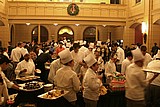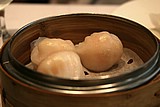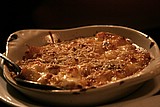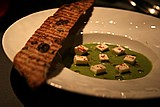Home |
Restaurants by City
|
Food Photography |
Archive | Philosophy |
![]()
Right now we are eating in Seattle, Washington.
|
Monday
2006
Permalink
|
A Week at the Culinary Institute of America (continued) - Student Life, Hyde Park, NY, tasted on December 19-22, 2005 Being at the C.I.A. for a week obviously couldn't give us a complete sense for life on campus. But we got glimpses. Glimpses that frankly made us jealous. Don't get me wrong, it was clear everyone was working hard in a very disciplined environment (for some reason students aren't allowed to wear hats... we saw two occasions on which faculty members came up to students reminding them sternly to remove non-toques). What follows hopefully gives you a slight taste of what it's like to be a student at the C.I.A which is essentially why we were there in the first place. Most of the students on campus are there for 2 and 4 year programs. But because of the way the school operates they appear to take 18 and 36 months respectively. Apparently there's a rolling three week window giving folks an opportunity to start their education every three weeks. As we toured the facilities we got a chance to see the students in action. We would pass various classrooms with students engaged in every manner of the study and practice of cooking, baking, and professional food preparation and management. The students usually looked pretty happy too. We got plenty of smiles and waves as our obviously non-regular student bunch peered in through windows with wide eyes watching a couple of dozen kids scaling fish or baking bread. Some classrooms were just classrooms where students were hitting the books. Some were kitchens working on food without a clear destination. But many of the kitchens were there to feed the other students breakfast, lunch, and dinner. By the way, even though our class didn't start until 7am, we were at the school by 6am as breakfast was essentially over by 6:15 am. Now consider when the breakfast kitchen students arrived. And now consider when the folks baking the fresh bread for the breakfast kitchen arrived to achieve that feat. Youch! I will say this though. The C.I.A. serves the best cafeteria food I have ever eaten in my life. Seriously, the kitchen next to ours that fed us each day was generating really decent food every day. It can really impact the students as I'll show below. Lunch was something to really look forward to every day, and you were rooting for it to be decent as you were hoping you could feel good about the work the students were doing in the kitchen next to yours. There's something you should know about the C.I.A. And after I say it, it's going to seem obvious. And many of you will say you already know this. But there's a difference in knowing something intellectually versus really understanding it and internalizing it. The Culinary Institute of America is focused on preparing its students to be professional food service workers. From entry level prep cook to executive chef and all the other roles in between and on other tracks. This is very different than preparing students to be the best chefs in the world. The reason is because 99.9% of the jobs in the industry aren't opening your own tiny perfect restaurant where you call all the shots and make wonderful and original food for a loyal fanatical audience. Most of the jobs are in places like catering companies, corporate cafeterias, hotel restaurants, etc. The C.I.A.'s responsibility is to help its graduates get paying jobs and they take their responsibility seriously. It only makes sense. Every week (or is it every three weeks... I wasn't sure) when the students put on a "grand buffet" in the main hall you'll understand why it might remind you of a cruise ship. Before you get upset, it's good cruise ship food. But cruise ship nonetheless. World class food is almost always prepared a la minute, not en masse. These folks are learning a lot of things, but one of them is definitely how to cook at scale. And frankly you have to learn this before you can learn how to cook with excellence for just a few. This is because cooking at scale will challenge you like nothing ever has. Add budget constraints and health regulations and you'll really have a challenge. As big buffets go, this was definitely a good one. The students were, well, adorable serving up their dishes to the other students milling about and getting their fill of all the small dishes on display. Even the chocolates we had only been able to gaze at through a window before were now finally available for consumption. The only thing that deserves rightful complaint was the huge pile of "non-edible bread". I suppose making decorative adornments out of bread is a useful skill, but I think putting anything out you can't eat is not ok. To put huge warning signs on said bread ruined even any visual value they might have conveyed. I think the legal department made up the signs for this table.
I think the single best line I heard that describes life at the C.I.A. as a student went as follows: "Most colleges have the freshman 15. We have the freshman 30."
|
|||
Our Sponsors
Free Car Listings Hot Tubs Stools Saunas Bar Stools - Calendar and Event Schedules - Food Events and Calendars - Wine Events and Calendars - Digital Photography Resources - Software for Advertisers - Jewish Gifts and Judaica - Howard Stern Podcast - ponytailed blogger Jonathan Schwartz

Browse tastingmenu
Home |
Restaurants by City X |
Food Photography |
Archive | Philosophy |
![]()
Free eBooks: All About Apples
| Autumn Omakase
More:
Discussion |
Cool Food T-Shirts |
Ingredients
| Markets |
Recipes
Search |
Blog FAQ |
Other
Blogs
Best of tastingmenu
|
City View
Entry: July 6, 2006 |
Blue Plate
Entry: June 19, 2006 |
L'Atelier de Joël Robuchon
Entry: July 18, 2006 |
Browse by City
Boston | Chicago | Houston | Las Vegas | Los Angeles | Maui | New York | Philadelphia | Portland | San Francisco | Seattle | Toronto | Utah | Vancouver | Washington D.C.
Bangkok | Beijing | Hong Kong | Seoul | Tokyo
Amsterdam | Berlin | Italy | London | Madrid | Paris | Vienna
Browse by Month
2006
2005
2004
2003
2002
2001
Comments, questions, or feedback:
info / at / tastingmenu / dot / com
All pages Copyright (c) 2001-2006 tastingmenu.com
Last modified 01/30/07.





